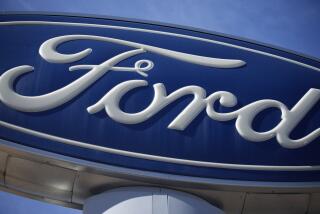Shifting Gears : U.S., Ford to Develop Cars With 2 Propulsion Systems
- Share via
DETROIT — Hoping to overcome the limited range of electric vehicles, Ford Motor Co. and the U.S. Department of Energy said Thursday they would jointly develop a hybrid vehicle within five years.
The $122-million agreement is part of the first major initiative taken under the Clinton Administration’s “supercar” program. It comes as Detroit auto makers have stepped up their fight to repeal California’s mandate that they sell electric vehicles in the state by 1998.
Hybrid vehicles contain two propulsion systems--typically one powered by a battery-driven electric motor and the other an internal-combustion engine using gasoline or a similar fuel.
Researchers say hybrid cars can achieve a better range than electric vehicles, which now are limited to about 100 miles per charge. While not as clean as electric vehicles, hybrids have better fuel economy and lower emissions than gas-powered cars.
But there are many hurdles to overcome. Meshing two drive systems is difficult. The second power system adds weight that reduces fuel efficiency. And the need for two engines increases the cost.
“Hybrids are even more complex than dedicated electrics,” said Bradford Bates, who heads Ford’s hybrid research team.
Hybrid development is among more than a dozen technologies targeted by the supercar program, a joint government-industry effort to build vehicles within a decade that are three times more fuel-efficient than today’s models.
Christine Ervin, assistant energy secretary for energy efficiency, said a marketable hybrid vehicle could reduce reliance on imported oil, improve environmental quality and create business opportunities.
The Ford hybrid program is the second to gain support from the Energy Department. The agency signed a similar, $138-million development agreement with General Motors in September. Ford and GM will pursue their hybrid prototypes separately.
Both auto makers are working with experts from universities, utilities and supplier companies. The federal government is lending the support of national laboratories in California, New Mexico and Tennessee, with costs shared equally by the companies and taxpayers.
Ford plans to explore the practicality of several hybrid types. One is the range-extended electric, a traditional electric car equipped with a small gas-powered engine that kicks in if the battery goes dead.
“You could limp home, so to speak,” Bates said.
Another alternative is a series hybrid, which allows the vehicle to run on either an electric motor or its gas engine. Ford also will evaluate parallel hybrids, which allow both power systems to operate simultaneously.
“It’s certainly possible that we could have hybrid vehicles on the road in five to 10 years,” Bates said.
In a little more than four years, California is requiring that 2% of cars and trucks sold in the state be zero-emission vehicles--an aim that can be met only by electrics. The mandate increases to 5% in 2001 and 10% in 2003.
The auto makers argue that the technology is not yet available to produce affordable electric vehicles with the range, comfort and performance of conventional vehicles.
Alexander Trotman, Ford’s chairman and chief executive, said this week that the company was pressing its case with California officials.
“We are being heard,” he said.
Asked if hybrids were a possible alternative to electric vehicles, Trotman said they could improve range and lower emissions, but that their cost would be too high.
Power Times Two
Though they can take many forms, hybrids share one characteristic: They pair two power sources, one electric and one conventional, in a single vehicle to extend the range and usefulness of what is at heart an electric car. Perhaps the least exotic concept is the range-extended hybrid, below, which adds a small, inexpensive auxiliary power unit to the electric car.
The extra unit--presumably gasoline powered--would provide “limp home” capability when the batteries are nearly discharged.
Other hybrids concepts under study include:
* The series hybrid. The vehicle could operate using either its conventional internal-combustion engine or an electric motor powered by batteries or flywheels. The gasoline engine also could be used to recharge the electric power sources.
* The coupled parallel hybrid. Both an internal combustion engine and an electric motor (powered by batteries, flywheels or other energy sources) are coupled to the same set of wheels to drive the vehicle. The two motors could be designed either to run in tandem or separately.
* The separated parallel hybrid. An internal-combustion engine would drive one set of wheels and an electric motor would drive the other. The motors could be used at the same time or independently.






